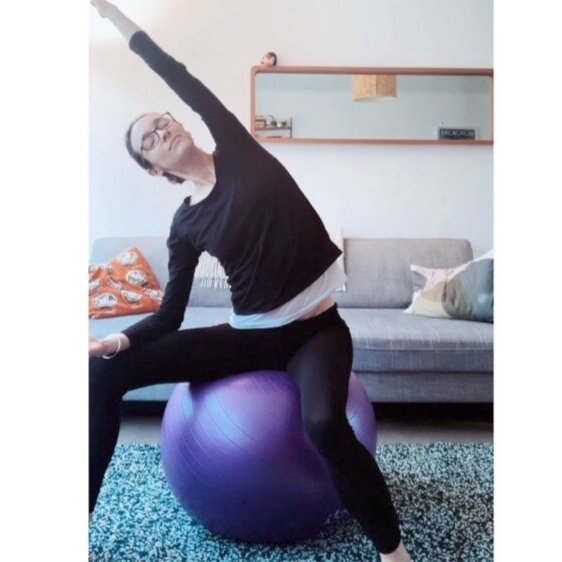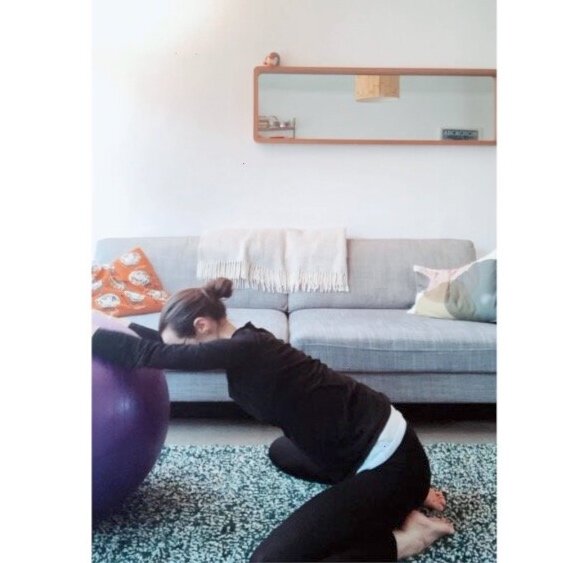Why and how to use a birth ball in pregnancy?
Birth balls - which are no different than gym balls - are a fantastic prop to use in pregnancy and, despite their name, they’re not only good to use during labour and birth (although they are great for that too)!
Pregnancy/ birth balls and can actually be used in a variety of ways throughout pregnancy, labour and even postnatally, and might actually prove to be one of the best buys of your pregnancy. And they’re really affordable too (you can find some for about £10)!
Benefits of birthing balls
Because birthing balls naturally encourage you to adopt a better, straighter posture, and support your weight more equally with your feet flat on the ground, sitting on a birthing ball is a much better option for the pregnant body than most squishy furniture such as armchairs and sofas. This is especially true in later pregnancy, when it is harder to get comfortable and to get up and down from a sitting position.
Birthing balls are also great to help you enjoy a range of movements without bearing weight, and encourage baby in a good position too as you get near the end of your pregnancy.
This will help relieve tension and discomfort in the lower back, stabilise your pelvic joints (great if you’re suffering from PGP/ pelvic pain), find more space for you to breathe and can help relieve heartburn/reflux too.
Birthing balls also make great resting props too.
How to choose a birth ball
Birth balls exist in different sizes, and choosing the right size for your height is essential. What you want to achieve is having your knees about 10cm lower than your hips, with feet flat on the floor. Generally speaking, this means that if you are up to 1.73cm tall (5ft 8in), it’s best to get a 65cm ball. If you’re taller, it’s best to get a 75cm ball.
Birthing balls will lose some air/tension over time and use so check regularly that your ball is still inflated to the right size and pump it up as needed (you can make a discreet mark on a wall showing the height it should be for a quick check).
How to use a birthing ball in pregnancy?
You can start using a pregnancy ball at any point in pregnancy. From 32 weeks, you may want to use your ball on a daily basis, as an alternative to a desk chair or to the sofa. A lot of the movements you can do on the ball are great to use in labour too, so you will be helping your body and well-being as well as your birth preparation in one go!
Here are a few simple and deeply enjoyable pregnancy yoga movements you can try!
Pelvic circles & spirals
Simply roll your hips to draw circles on the ball, one way then the other. You can start with small circles then make them bigger and bigger like a spiral and back to small. Take your arms out to side for better balance if needed (and it feels joyful too!)
Bouncing circles
Gentle bounce on the ball while describing a small circle as above, again going one way then the other.
Warrior 2
A ball is a great way to access the grounding feeling and strengthening of Warrior 2 right till the end of your pregnancy (without bearing the weight of your bump) and/or while keeping a shorter stance (if you have any sort of pelvic pain). Ensure both feet are fully grounded on the floor.
Extended side stretch
From Warrior 2, enjoy this side stretch (bend the arm at the elbow if you have high blood pressure) to find more space to breathe, stretch the abdominals and relieve tension in the back!
Extended child’s pose
Kneeling on the floor, knees apart to make space for your bump, reach your arms over the ball to enjoy a back stretch. You can roll the ball side to side a little for a little swaying movement, then roll it closer to you and rest your head on folded arms for a comfortable rest.
Enjoyed these movements? Want to learn and explore more?
Why not join me for my weekly pregnancy yoga classes in Richmond, London, or explore my online signature course & recorded library, to enjoy from the comfort of your home?
Or if you are looking to prepare specifically for labour and birth, have a look at my Birth Skills online workshop, in which we explore the most optimal positions, movements, breathing techniques and birth partner support for each stage of labour (and how to use a ball!).






